Customer Experience Management Report: Fenchurch Restaurant Analysis
VerifiedAdded on 2023/01/03
|11
|2936
|74
Report
AI Summary
This report provides a comprehensive analysis of customer experience management, focusing on Fenchurch Restaurant. It begins by exploring the importance of understanding customer needs, wants, and preferences within the service sector, discussing factors that drive customer engagement and how these factors influence on-boarding strategies. The report includes a customer experience map for Fenchurch Restaurant, analyzing customer touchpoints and identifying opportunities for business growth. It also examines the role of digital technology, including customer relationship management (CRM) systems, in enhancing customer experience within the service sector. The report concludes with a review of how digital technology is changing CRM systems for customer acquisition and retention. The study provides ways for effective customer management services.
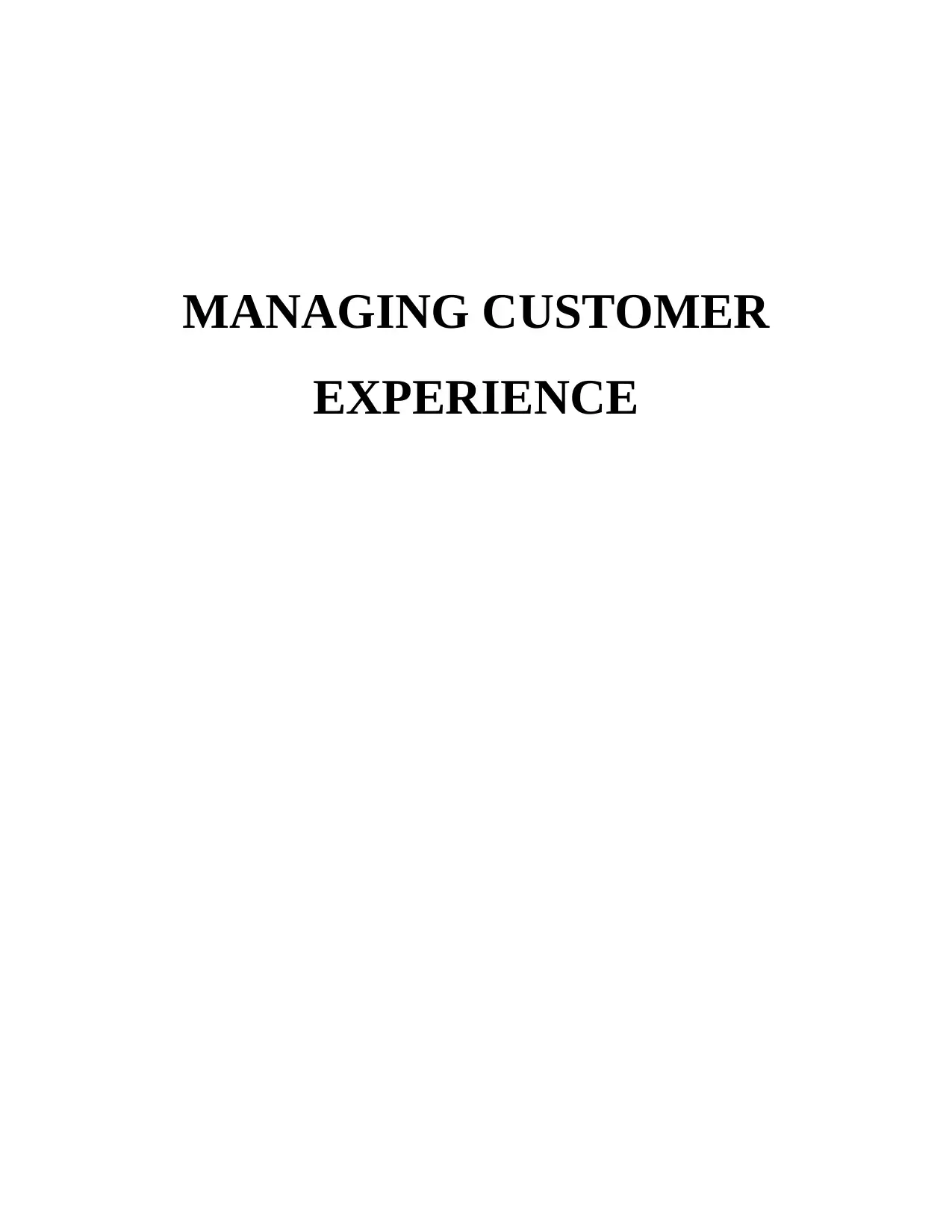
MANAGING CUSTOMER
EXPERIENCE
EXPERIENCE
Paraphrase This Document
Need a fresh take? Get an instant paraphrase of this document with our AI Paraphraser
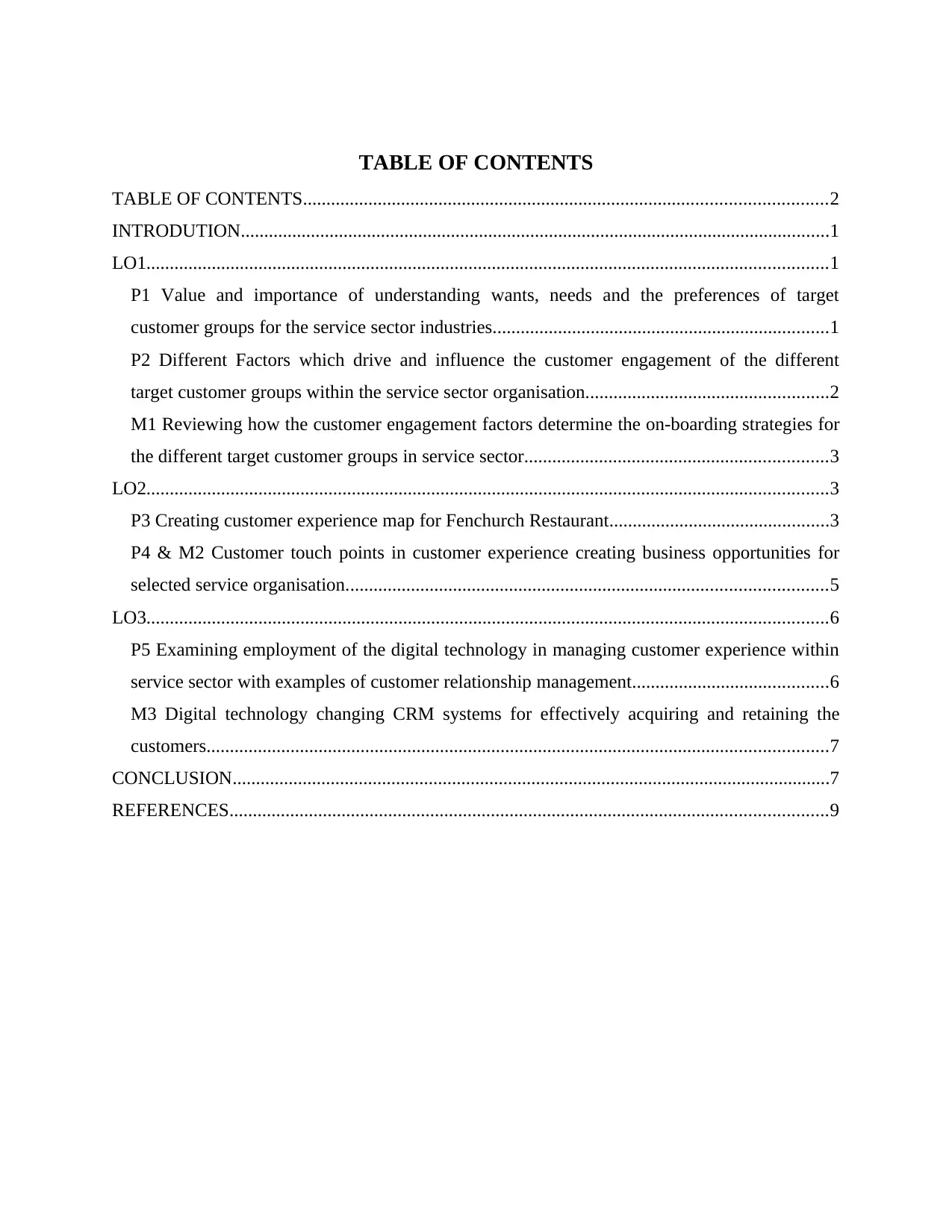
TABLE OF CONTENTS
TABLE OF CONTENTS................................................................................................................2
INTRODUTION..............................................................................................................................1
LO1..................................................................................................................................................1
P1 Value and importance of understanding wants, needs and the preferences of target
customer groups for the service sector industries........................................................................1
P2 Different Factors which drive and influence the customer engagement of the different
target customer groups within the service sector organisation....................................................2
M1 Reviewing how the customer engagement factors determine the on-boarding strategies for
the different target customer groups in service sector.................................................................3
LO2..................................................................................................................................................3
P3 Creating customer experience map for Fenchurch Restaurant...............................................3
P4 & M2 Customer touch points in customer experience creating business opportunities for
selected service organisation.......................................................................................................5
LO3..................................................................................................................................................6
P5 Examining employment of the digital technology in managing customer experience within
service sector with examples of customer relationship management..........................................6
M3 Digital technology changing CRM systems for effectively acquiring and retaining the
customers.....................................................................................................................................7
CONCLUSION................................................................................................................................7
REFERENCES................................................................................................................................9
TABLE OF CONTENTS................................................................................................................2
INTRODUTION..............................................................................................................................1
LO1..................................................................................................................................................1
P1 Value and importance of understanding wants, needs and the preferences of target
customer groups for the service sector industries........................................................................1
P2 Different Factors which drive and influence the customer engagement of the different
target customer groups within the service sector organisation....................................................2
M1 Reviewing how the customer engagement factors determine the on-boarding strategies for
the different target customer groups in service sector.................................................................3
LO2..................................................................................................................................................3
P3 Creating customer experience map for Fenchurch Restaurant...............................................3
P4 & M2 Customer touch points in customer experience creating business opportunities for
selected service organisation.......................................................................................................5
LO3..................................................................................................................................................6
P5 Examining employment of the digital technology in managing customer experience within
service sector with examples of customer relationship management..........................................6
M3 Digital technology changing CRM systems for effectively acquiring and retaining the
customers.....................................................................................................................................7
CONCLUSION................................................................................................................................7
REFERENCES................................................................................................................................9
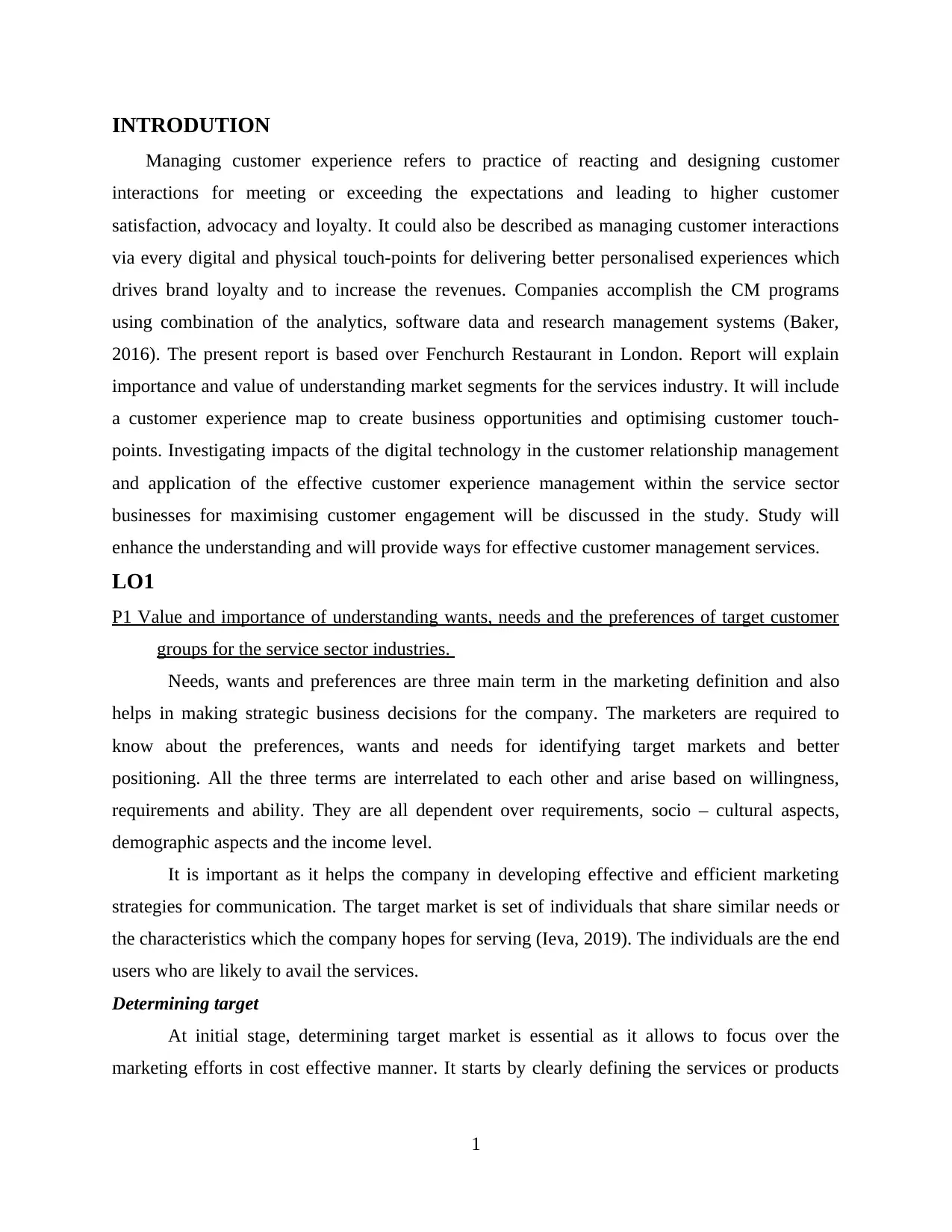
INTRODUTION
Managing customer experience refers to practice of reacting and designing customer
interactions for meeting or exceeding the expectations and leading to higher customer
satisfaction, advocacy and loyalty. It could also be described as managing customer interactions
via every digital and physical touch-points for delivering better personalised experiences which
drives brand loyalty and to increase the revenues. Companies accomplish the CM programs
using combination of the analytics, software data and research management systems (Baker,
2016). The present report is based over Fenchurch Restaurant in London. Report will explain
importance and value of understanding market segments for the services industry. It will include
a customer experience map to create business opportunities and optimising customer touch-
points. Investigating impacts of the digital technology in the customer relationship management
and application of the effective customer experience management within the service sector
businesses for maximising customer engagement will be discussed in the study. Study will
enhance the understanding and will provide ways for effective customer management services.
LO1
P1 Value and importance of understanding wants, needs and the preferences of target customer
groups for the service sector industries.
Needs, wants and preferences are three main term in the marketing definition and also
helps in making strategic business decisions for the company. The marketers are required to
know about the preferences, wants and needs for identifying target markets and better
positioning. All the three terms are interrelated to each other and arise based on willingness,
requirements and ability. They are all dependent over requirements, socio – cultural aspects,
demographic aspects and the income level.
It is important as it helps the company in developing effective and efficient marketing
strategies for communication. The target market is set of individuals that share similar needs or
the characteristics which the company hopes for serving (Ieva, 2019). The individuals are the end
users who are likely to avail the services.
Determining target
At initial stage, determining target market is essential as it allows to focus over the
marketing efforts in cost effective manner. It starts by clearly defining the services or products
1
Managing customer experience refers to practice of reacting and designing customer
interactions for meeting or exceeding the expectations and leading to higher customer
satisfaction, advocacy and loyalty. It could also be described as managing customer interactions
via every digital and physical touch-points for delivering better personalised experiences which
drives brand loyalty and to increase the revenues. Companies accomplish the CM programs
using combination of the analytics, software data and research management systems (Baker,
2016). The present report is based over Fenchurch Restaurant in London. Report will explain
importance and value of understanding market segments for the services industry. It will include
a customer experience map to create business opportunities and optimising customer touch-
points. Investigating impacts of the digital technology in the customer relationship management
and application of the effective customer experience management within the service sector
businesses for maximising customer engagement will be discussed in the study. Study will
enhance the understanding and will provide ways for effective customer management services.
LO1
P1 Value and importance of understanding wants, needs and the preferences of target customer
groups for the service sector industries.
Needs, wants and preferences are three main term in the marketing definition and also
helps in making strategic business decisions for the company. The marketers are required to
know about the preferences, wants and needs for identifying target markets and better
positioning. All the three terms are interrelated to each other and arise based on willingness,
requirements and ability. They are all dependent over requirements, socio – cultural aspects,
demographic aspects and the income level.
It is important as it helps the company in developing effective and efficient marketing
strategies for communication. The target market is set of individuals that share similar needs or
the characteristics which the company hopes for serving (Ieva, 2019). The individuals are the end
users who are likely to avail the services.
Determining target
At initial stage, determining target market is essential as it allows to focus over the
marketing efforts in cost effective manner. It starts by clearly defining the services or products
1
⊘ This is a preview!⊘
Do you want full access?
Subscribe today to unlock all pages.

Trusted by 1+ million students worldwide
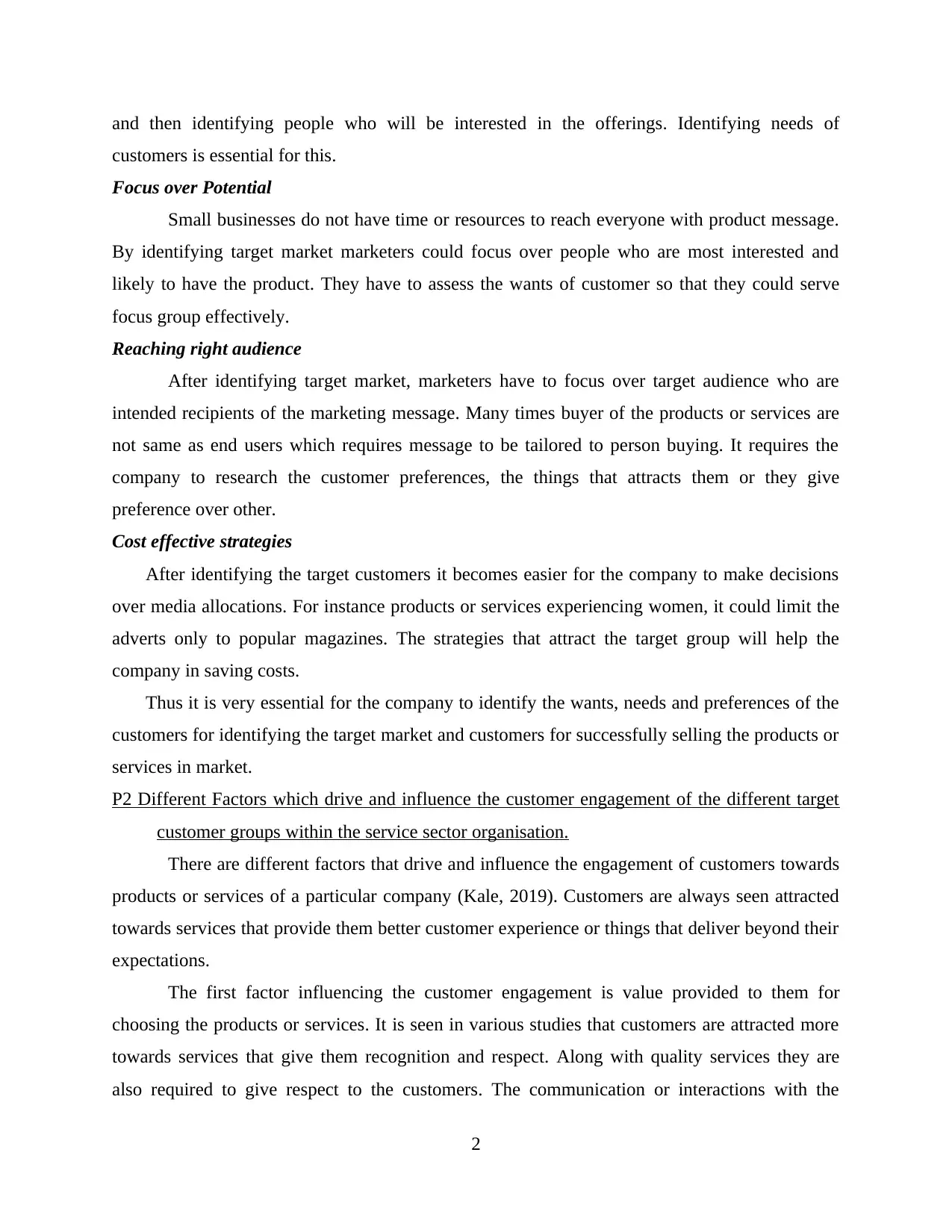
and then identifying people who will be interested in the offerings. Identifying needs of
customers is essential for this.
Focus over Potential
Small businesses do not have time or resources to reach everyone with product message.
By identifying target market marketers could focus over people who are most interested and
likely to have the product. They have to assess the wants of customer so that they could serve
focus group effectively.
Reaching right audience
After identifying target market, marketers have to focus over target audience who are
intended recipients of the marketing message. Many times buyer of the products or services are
not same as end users which requires message to be tailored to person buying. It requires the
company to research the customer preferences, the things that attracts them or they give
preference over other.
Cost effective strategies
After identifying the target customers it becomes easier for the company to make decisions
over media allocations. For instance products or services experiencing women, it could limit the
adverts only to popular magazines. The strategies that attract the target group will help the
company in saving costs.
Thus it is very essential for the company to identify the wants, needs and preferences of the
customers for identifying the target market and customers for successfully selling the products or
services in market.
P2 Different Factors which drive and influence the customer engagement of the different target
customer groups within the service sector organisation.
There are different factors that drive and influence the engagement of customers towards
products or services of a particular company (Kale, 2019). Customers are always seen attracted
towards services that provide them better customer experience or things that deliver beyond their
expectations.
The first factor influencing the customer engagement is value provided to them for
choosing the products or services. It is seen in various studies that customers are attracted more
towards services that give them recognition and respect. Along with quality services they are
also required to give respect to the customers. The communication or interactions with the
2
customers is essential for this.
Focus over Potential
Small businesses do not have time or resources to reach everyone with product message.
By identifying target market marketers could focus over people who are most interested and
likely to have the product. They have to assess the wants of customer so that they could serve
focus group effectively.
Reaching right audience
After identifying target market, marketers have to focus over target audience who are
intended recipients of the marketing message. Many times buyer of the products or services are
not same as end users which requires message to be tailored to person buying. It requires the
company to research the customer preferences, the things that attracts them or they give
preference over other.
Cost effective strategies
After identifying the target customers it becomes easier for the company to make decisions
over media allocations. For instance products or services experiencing women, it could limit the
adverts only to popular magazines. The strategies that attract the target group will help the
company in saving costs.
Thus it is very essential for the company to identify the wants, needs and preferences of the
customers for identifying the target market and customers for successfully selling the products or
services in market.
P2 Different Factors which drive and influence the customer engagement of the different target
customer groups within the service sector organisation.
There are different factors that drive and influence the engagement of customers towards
products or services of a particular company (Kale, 2019). Customers are always seen attracted
towards services that provide them better customer experience or things that deliver beyond their
expectations.
The first factor influencing the customer engagement is value provided to them for
choosing the products or services. It is seen in various studies that customers are attracted more
towards services that give them recognition and respect. Along with quality services they are
also required to give respect to the customers. The communication or interactions with the
2
Paraphrase This Document
Need a fresh take? Get an instant paraphrase of this document with our AI Paraphraser
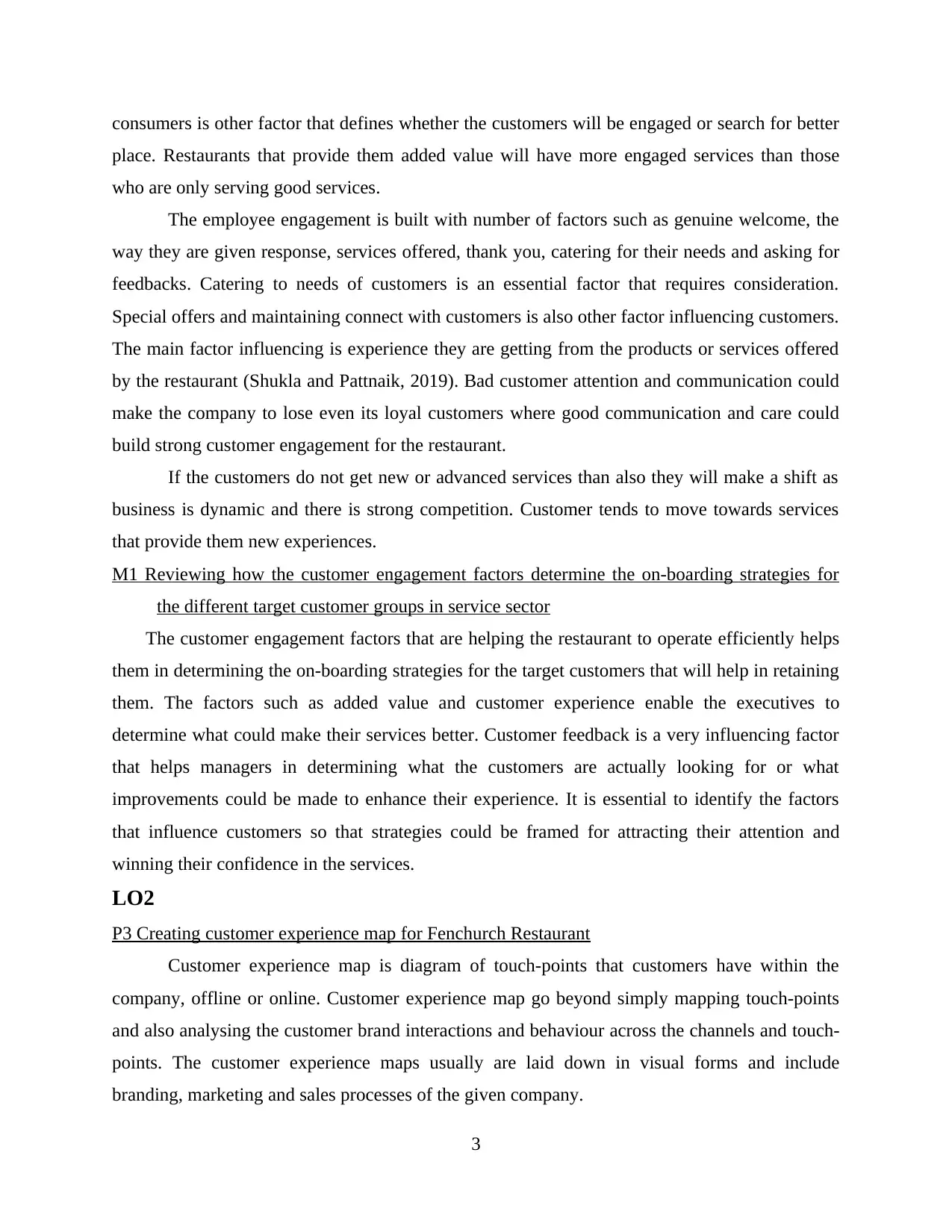
consumers is other factor that defines whether the customers will be engaged or search for better
place. Restaurants that provide them added value will have more engaged services than those
who are only serving good services.
The employee engagement is built with number of factors such as genuine welcome, the
way they are given response, services offered, thank you, catering for their needs and asking for
feedbacks. Catering to needs of customers is an essential factor that requires consideration.
Special offers and maintaining connect with customers is also other factor influencing customers.
The main factor influencing is experience they are getting from the products or services offered
by the restaurant (Shukla and Pattnaik, 2019). Bad customer attention and communication could
make the company to lose even its loyal customers where good communication and care could
build strong customer engagement for the restaurant.
If the customers do not get new or advanced services than also they will make a shift as
business is dynamic and there is strong competition. Customer tends to move towards services
that provide them new experiences.
M1 Reviewing how the customer engagement factors determine the on-boarding strategies for
the different target customer groups in service sector
The customer engagement factors that are helping the restaurant to operate efficiently helps
them in determining the on-boarding strategies for the target customers that will help in retaining
them. The factors such as added value and customer experience enable the executives to
determine what could make their services better. Customer feedback is a very influencing factor
that helps managers in determining what the customers are actually looking for or what
improvements could be made to enhance their experience. It is essential to identify the factors
that influence customers so that strategies could be framed for attracting their attention and
winning their confidence in the services.
LO2
P3 Creating customer experience map for Fenchurch Restaurant
Customer experience map is diagram of touch-points that customers have within the
company, offline or online. Customer experience map go beyond simply mapping touch-points
and also analysing the customer brand interactions and behaviour across the channels and touch-
points. The customer experience maps usually are laid down in visual forms and include
branding, marketing and sales processes of the given company.
3
place. Restaurants that provide them added value will have more engaged services than those
who are only serving good services.
The employee engagement is built with number of factors such as genuine welcome, the
way they are given response, services offered, thank you, catering for their needs and asking for
feedbacks. Catering to needs of customers is an essential factor that requires consideration.
Special offers and maintaining connect with customers is also other factor influencing customers.
The main factor influencing is experience they are getting from the products or services offered
by the restaurant (Shukla and Pattnaik, 2019). Bad customer attention and communication could
make the company to lose even its loyal customers where good communication and care could
build strong customer engagement for the restaurant.
If the customers do not get new or advanced services than also they will make a shift as
business is dynamic and there is strong competition. Customer tends to move towards services
that provide them new experiences.
M1 Reviewing how the customer engagement factors determine the on-boarding strategies for
the different target customer groups in service sector
The customer engagement factors that are helping the restaurant to operate efficiently helps
them in determining the on-boarding strategies for the target customers that will help in retaining
them. The factors such as added value and customer experience enable the executives to
determine what could make their services better. Customer feedback is a very influencing factor
that helps managers in determining what the customers are actually looking for or what
improvements could be made to enhance their experience. It is essential to identify the factors
that influence customers so that strategies could be framed for attracting their attention and
winning their confidence in the services.
LO2
P3 Creating customer experience map for Fenchurch Restaurant
Customer experience map is diagram of touch-points that customers have within the
company, offline or online. Customer experience map go beyond simply mapping touch-points
and also analysing the customer brand interactions and behaviour across the channels and touch-
points. The customer experience maps usually are laid down in visual forms and include
branding, marketing and sales processes of the given company.
3
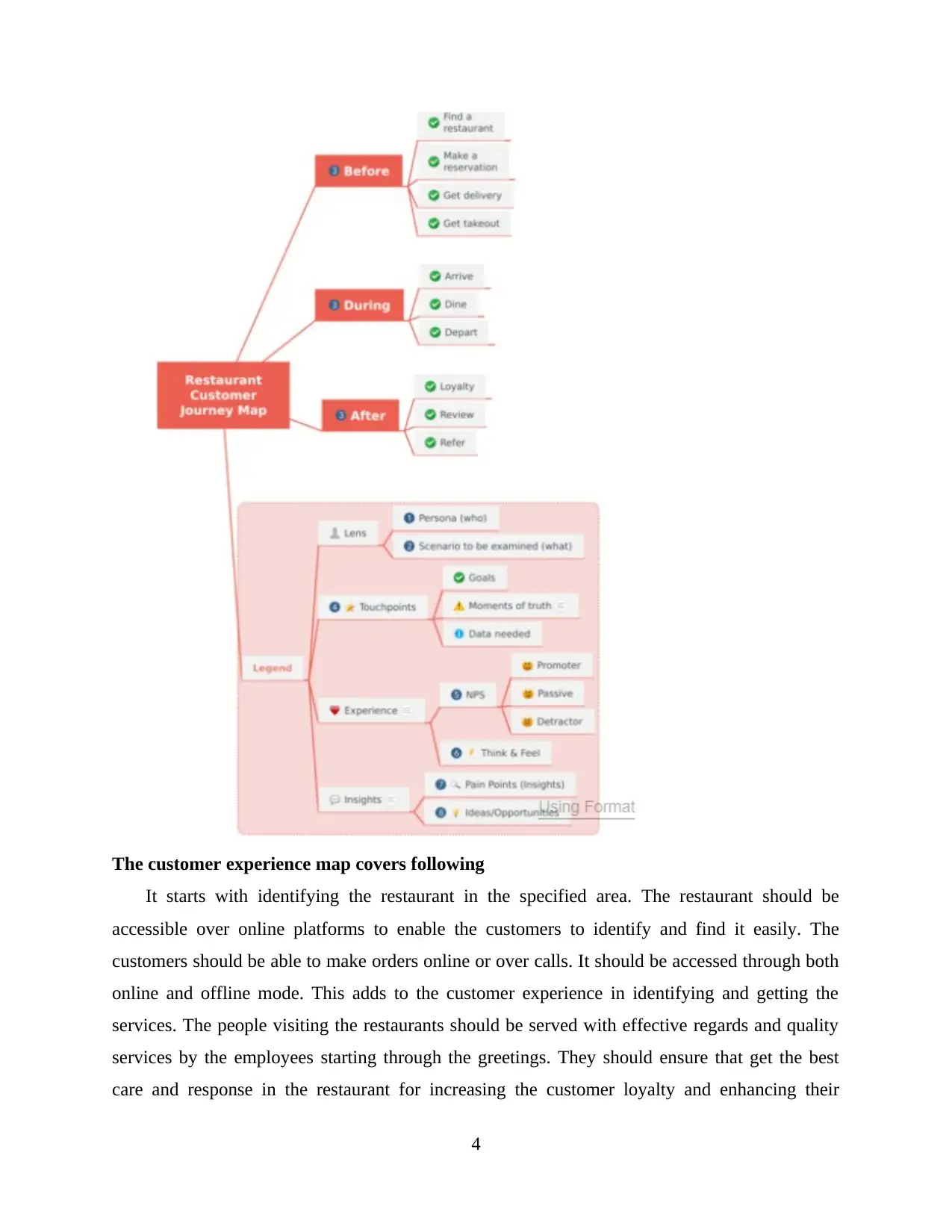
The customer experience map covers following
It starts with identifying the restaurant in the specified area. The restaurant should be
accessible over online platforms to enable the customers to identify and find it easily. The
customers should be able to make orders online or over calls. It should be accessed through both
online and offline mode. This adds to the customer experience in identifying and getting the
services. The people visiting the restaurants should be served with effective regards and quality
services by the employees starting through the greetings. They should ensure that get the best
care and response in the restaurant for increasing the customer loyalty and enhancing their
4
It starts with identifying the restaurant in the specified area. The restaurant should be
accessible over online platforms to enable the customers to identify and find it easily. The
customers should be able to make orders online or over calls. It should be accessed through both
online and offline mode. This adds to the customer experience in identifying and getting the
services. The people visiting the restaurants should be served with effective regards and quality
services by the employees starting through the greetings. They should ensure that get the best
care and response in the restaurant for increasing the customer loyalty and enhancing their
4
⊘ This is a preview!⊘
Do you want full access?
Subscribe today to unlock all pages.

Trusted by 1+ million students worldwide
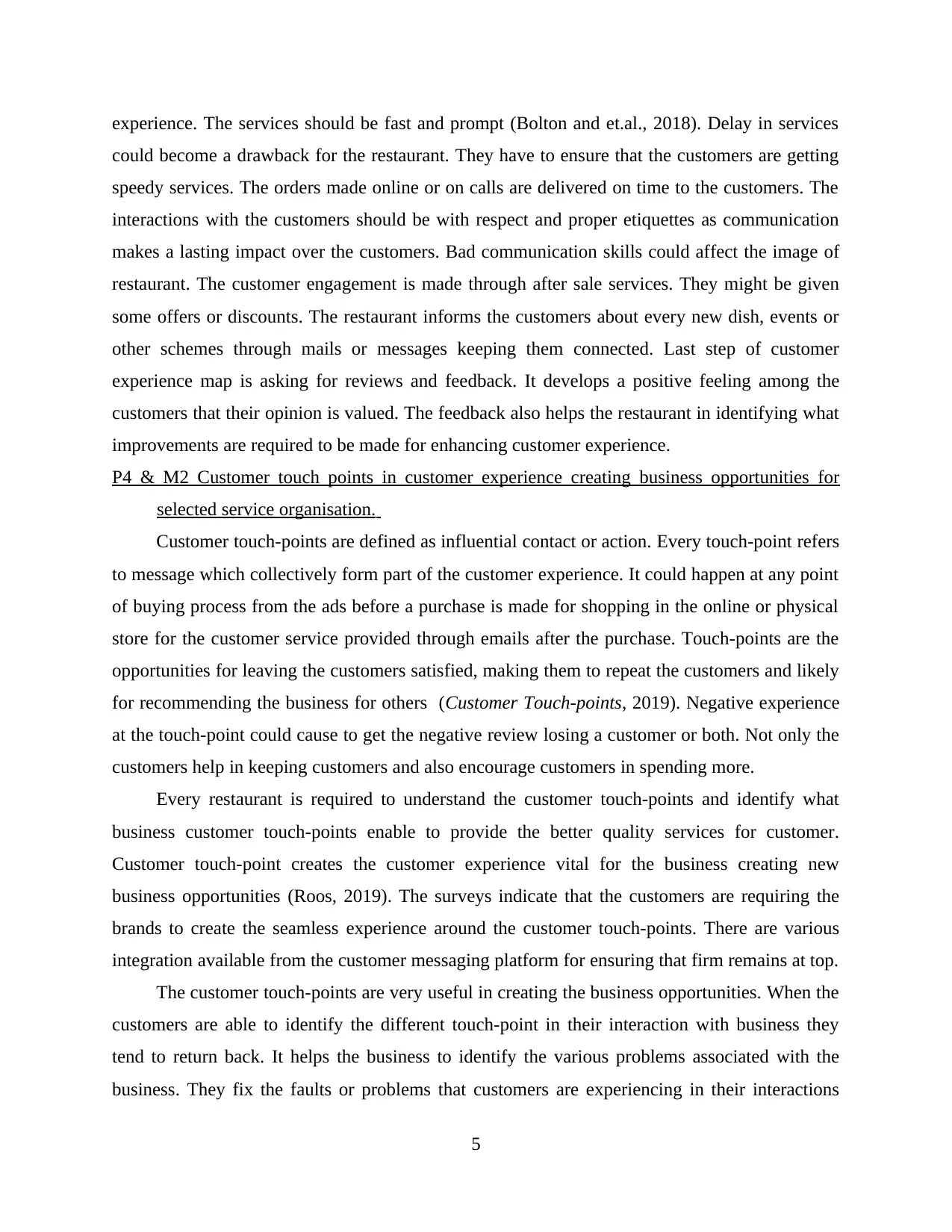
experience. The services should be fast and prompt (Bolton and et.al., 2018). Delay in services
could become a drawback for the restaurant. They have to ensure that the customers are getting
speedy services. The orders made online or on calls are delivered on time to the customers. The
interactions with the customers should be with respect and proper etiquettes as communication
makes a lasting impact over the customers. Bad communication skills could affect the image of
restaurant. The customer engagement is made through after sale services. They might be given
some offers or discounts. The restaurant informs the customers about every new dish, events or
other schemes through mails or messages keeping them connected. Last step of customer
experience map is asking for reviews and feedback. It develops a positive feeling among the
customers that their opinion is valued. The feedback also helps the restaurant in identifying what
improvements are required to be made for enhancing customer experience.
P4 & M2 Customer touch points in customer experience creating business opportunities for
selected service organisation.
Customer touch-points are defined as influential contact or action. Every touch-point refers
to message which collectively form part of the customer experience. It could happen at any point
of buying process from the ads before a purchase is made for shopping in the online or physical
store for the customer service provided through emails after the purchase. Touch-points are the
opportunities for leaving the customers satisfied, making them to repeat the customers and likely
for recommending the business for others (Customer Touch-points, 2019). Negative experience
at the touch-point could cause to get the negative review losing a customer or both. Not only the
customers help in keeping customers and also encourage customers in spending more.
Every restaurant is required to understand the customer touch-points and identify what
business customer touch-points enable to provide the better quality services for customer.
Customer touch-point creates the customer experience vital for the business creating new
business opportunities (Roos, 2019). The surveys indicate that the customers are requiring the
brands to create the seamless experience around the customer touch-points. There are various
integration available from the customer messaging platform for ensuring that firm remains at top.
The customer touch-points are very useful in creating the business opportunities. When the
customers are able to identify the different touch-point in their interaction with business they
tend to return back. It helps the business to identify the various problems associated with the
business. They fix the faults or problems that customers are experiencing in their interactions
5
could become a drawback for the restaurant. They have to ensure that the customers are getting
speedy services. The orders made online or on calls are delivered on time to the customers. The
interactions with the customers should be with respect and proper etiquettes as communication
makes a lasting impact over the customers. Bad communication skills could affect the image of
restaurant. The customer engagement is made through after sale services. They might be given
some offers or discounts. The restaurant informs the customers about every new dish, events or
other schemes through mails or messages keeping them connected. Last step of customer
experience map is asking for reviews and feedback. It develops a positive feeling among the
customers that their opinion is valued. The feedback also helps the restaurant in identifying what
improvements are required to be made for enhancing customer experience.
P4 & M2 Customer touch points in customer experience creating business opportunities for
selected service organisation.
Customer touch-points are defined as influential contact or action. Every touch-point refers
to message which collectively form part of the customer experience. It could happen at any point
of buying process from the ads before a purchase is made for shopping in the online or physical
store for the customer service provided through emails after the purchase. Touch-points are the
opportunities for leaving the customers satisfied, making them to repeat the customers and likely
for recommending the business for others (Customer Touch-points, 2019). Negative experience
at the touch-point could cause to get the negative review losing a customer or both. Not only the
customers help in keeping customers and also encourage customers in spending more.
Every restaurant is required to understand the customer touch-points and identify what
business customer touch-points enable to provide the better quality services for customer.
Customer touch-point creates the customer experience vital for the business creating new
business opportunities (Roos, 2019). The surveys indicate that the customers are requiring the
brands to create the seamless experience around the customer touch-points. There are various
integration available from the customer messaging platform for ensuring that firm remains at top.
The customer touch-points are very useful in creating the business opportunities. When the
customers are able to identify the different touch-point in their interaction with business they
tend to return back. It helps the business to identify the various problems associated with the
business. They fix the faults or problems that customers are experiencing in their interactions
5
Paraphrase This Document
Need a fresh take? Get an instant paraphrase of this document with our AI Paraphraser
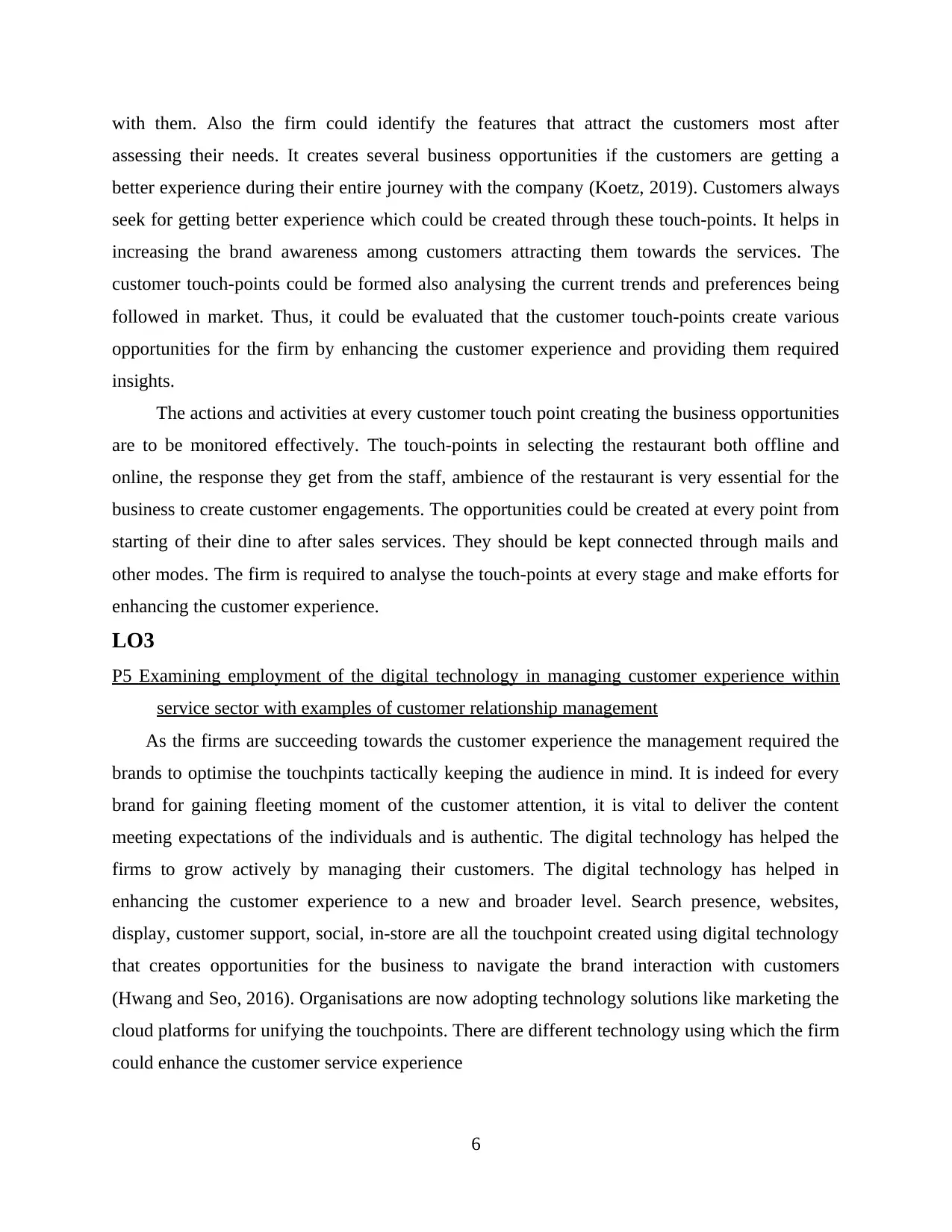
with them. Also the firm could identify the features that attract the customers most after
assessing their needs. It creates several business opportunities if the customers are getting a
better experience during their entire journey with the company (Koetz, 2019). Customers always
seek for getting better experience which could be created through these touch-points. It helps in
increasing the brand awareness among customers attracting them towards the services. The
customer touch-points could be formed also analysing the current trends and preferences being
followed in market. Thus, it could be evaluated that the customer touch-points create various
opportunities for the firm by enhancing the customer experience and providing them required
insights.
The actions and activities at every customer touch point creating the business opportunities
are to be monitored effectively. The touch-points in selecting the restaurant both offline and
online, the response they get from the staff, ambience of the restaurant is very essential for the
business to create customer engagements. The opportunities could be created at every point from
starting of their dine to after sales services. They should be kept connected through mails and
other modes. The firm is required to analyse the touch-points at every stage and make efforts for
enhancing the customer experience.
LO3
P5 Examining employment of the digital technology in managing customer experience within
service sector with examples of customer relationship management
As the firms are succeeding towards the customer experience the management required the
brands to optimise the touchpints tactically keeping the audience in mind. It is indeed for every
brand for gaining fleeting moment of the customer attention, it is vital to deliver the content
meeting expectations of the individuals and is authentic. The digital technology has helped the
firms to grow actively by managing their customers. The digital technology has helped in
enhancing the customer experience to a new and broader level. Search presence, websites,
display, customer support, social, in-store are all the touchpoint created using digital technology
that creates opportunities for the business to navigate the brand interaction with customers
(Hwang and Seo, 2016). Organisations are now adopting technology solutions like marketing the
cloud platforms for unifying the touchpoints. There are different technology using which the firm
could enhance the customer service experience
6
assessing their needs. It creates several business opportunities if the customers are getting a
better experience during their entire journey with the company (Koetz, 2019). Customers always
seek for getting better experience which could be created through these touch-points. It helps in
increasing the brand awareness among customers attracting them towards the services. The
customer touch-points could be formed also analysing the current trends and preferences being
followed in market. Thus, it could be evaluated that the customer touch-points create various
opportunities for the firm by enhancing the customer experience and providing them required
insights.
The actions and activities at every customer touch point creating the business opportunities
are to be monitored effectively. The touch-points in selecting the restaurant both offline and
online, the response they get from the staff, ambience of the restaurant is very essential for the
business to create customer engagements. The opportunities could be created at every point from
starting of their dine to after sales services. They should be kept connected through mails and
other modes. The firm is required to analyse the touch-points at every stage and make efforts for
enhancing the customer experience.
LO3
P5 Examining employment of the digital technology in managing customer experience within
service sector with examples of customer relationship management
As the firms are succeeding towards the customer experience the management required the
brands to optimise the touchpints tactically keeping the audience in mind. It is indeed for every
brand for gaining fleeting moment of the customer attention, it is vital to deliver the content
meeting expectations of the individuals and is authentic. The digital technology has helped the
firms to grow actively by managing their customers. The digital technology has helped in
enhancing the customer experience to a new and broader level. Search presence, websites,
display, customer support, social, in-store are all the touchpoint created using digital technology
that creates opportunities for the business to navigate the brand interaction with customers
(Hwang and Seo, 2016). Organisations are now adopting technology solutions like marketing the
cloud platforms for unifying the touchpoints. There are different technology using which the firm
could enhance the customer service experience
6
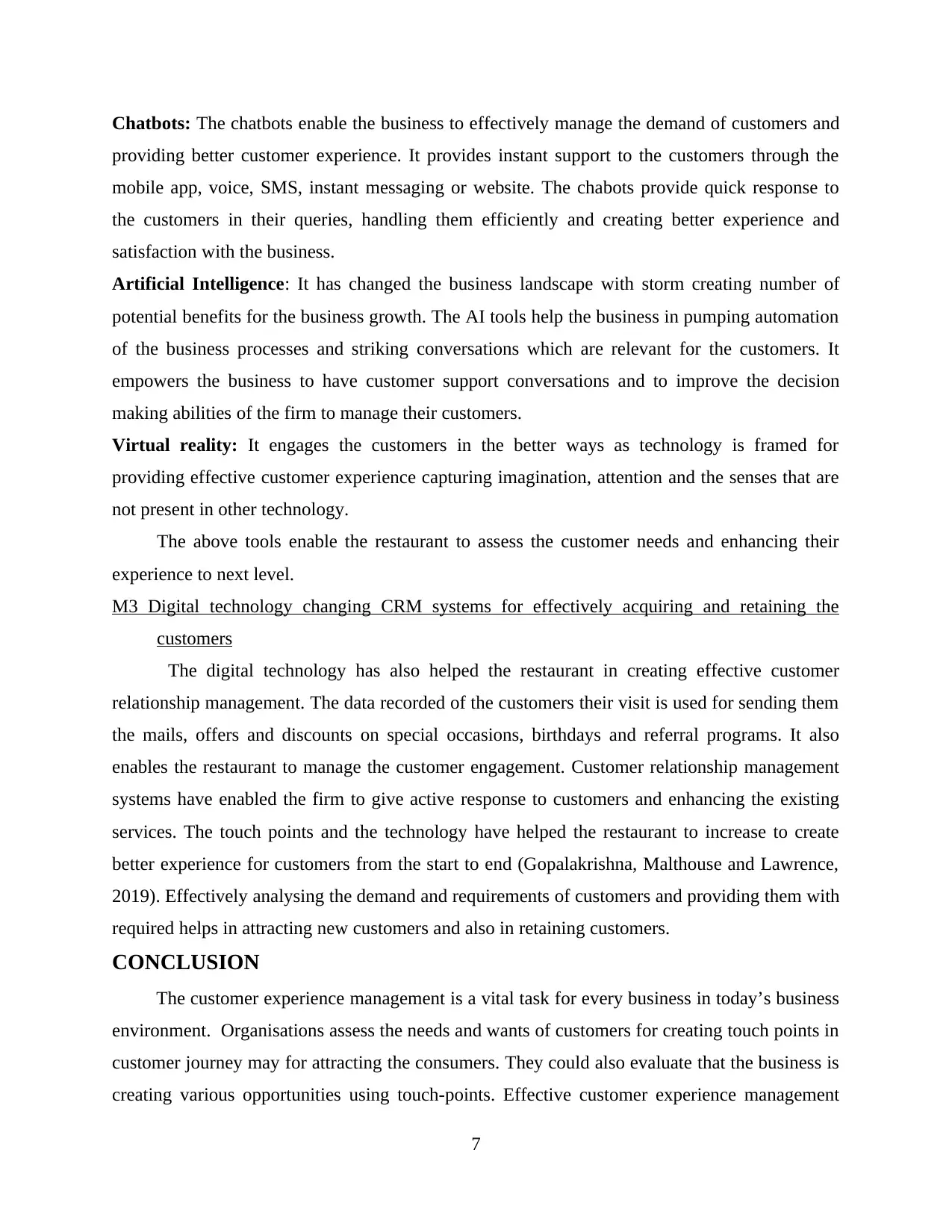
Chatbots: The chatbots enable the business to effectively manage the demand of customers and
providing better customer experience. It provides instant support to the customers through the
mobile app, voice, SMS, instant messaging or website. The chabots provide quick response to
the customers in their queries, handling them efficiently and creating better experience and
satisfaction with the business.
Artificial Intelligence: It has changed the business landscape with storm creating number of
potential benefits for the business growth. The AI tools help the business in pumping automation
of the business processes and striking conversations which are relevant for the customers. It
empowers the business to have customer support conversations and to improve the decision
making abilities of the firm to manage their customers.
Virtual reality: It engages the customers in the better ways as technology is framed for
providing effective customer experience capturing imagination, attention and the senses that are
not present in other technology.
The above tools enable the restaurant to assess the customer needs and enhancing their
experience to next level.
M3 Digital technology changing CRM systems for effectively acquiring and retaining the
customers
The digital technology has also helped the restaurant in creating effective customer
relationship management. The data recorded of the customers their visit is used for sending them
the mails, offers and discounts on special occasions, birthdays and referral programs. It also
enables the restaurant to manage the customer engagement. Customer relationship management
systems have enabled the firm to give active response to customers and enhancing the existing
services. The touch points and the technology have helped the restaurant to increase to create
better experience for customers from the start to end (Gopalakrishna, Malthouse and Lawrence,
2019). Effectively analysing the demand and requirements of customers and providing them with
required helps in attracting new customers and also in retaining customers.
CONCLUSION
The customer experience management is a vital task for every business in today’s business
environment. Organisations assess the needs and wants of customers for creating touch points in
customer journey may for attracting the consumers. They could also evaluate that the business is
creating various opportunities using touch-points. Effective customer experience management
7
providing better customer experience. It provides instant support to the customers through the
mobile app, voice, SMS, instant messaging or website. The chabots provide quick response to
the customers in their queries, handling them efficiently and creating better experience and
satisfaction with the business.
Artificial Intelligence: It has changed the business landscape with storm creating number of
potential benefits for the business growth. The AI tools help the business in pumping automation
of the business processes and striking conversations which are relevant for the customers. It
empowers the business to have customer support conversations and to improve the decision
making abilities of the firm to manage their customers.
Virtual reality: It engages the customers in the better ways as technology is framed for
providing effective customer experience capturing imagination, attention and the senses that are
not present in other technology.
The above tools enable the restaurant to assess the customer needs and enhancing their
experience to next level.
M3 Digital technology changing CRM systems for effectively acquiring and retaining the
customers
The digital technology has also helped the restaurant in creating effective customer
relationship management. The data recorded of the customers their visit is used for sending them
the mails, offers and discounts on special occasions, birthdays and referral programs. It also
enables the restaurant to manage the customer engagement. Customer relationship management
systems have enabled the firm to give active response to customers and enhancing the existing
services. The touch points and the technology have helped the restaurant to increase to create
better experience for customers from the start to end (Gopalakrishna, Malthouse and Lawrence,
2019). Effectively analysing the demand and requirements of customers and providing them with
required helps in attracting new customers and also in retaining customers.
CONCLUSION
The customer experience management is a vital task for every business in today’s business
environment. Organisations assess the needs and wants of customers for creating touch points in
customer journey may for attracting the consumers. They could also evaluate that the business is
creating various opportunities using touch-points. Effective customer experience management
7
⊘ This is a preview!⊘
Do you want full access?
Subscribe today to unlock all pages.

Trusted by 1+ million students worldwide

strategies are framed by the business for attracting and retaining the customers. Analysis of the
strategies is also done to improve and enhance the business strategies for providing better
customer experience.
8
strategies is also done to improve and enhance the business strategies for providing better
customer experience.
8
Paraphrase This Document
Need a fresh take? Get an instant paraphrase of this document with our AI Paraphraser
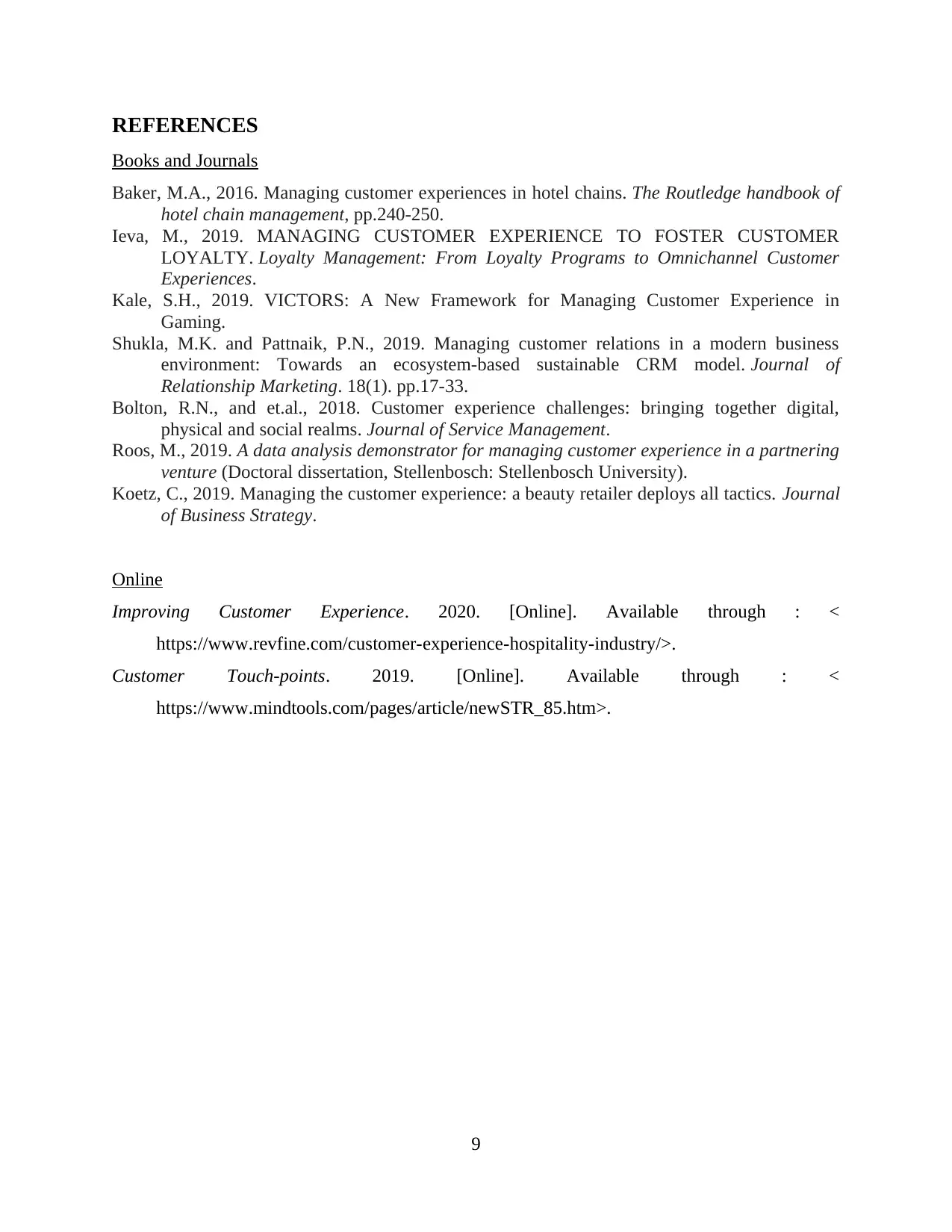
REFERENCES
Books and Journals
Baker, M.A., 2016. Managing customer experiences in hotel chains. The Routledge handbook of
hotel chain management, pp.240-250.
Ieva, M., 2019. MANAGING CUSTOMER EXPERIENCE TO FOSTER CUSTOMER
LOYALTY. Loyalty Management: From Loyalty Programs to Omnichannel Customer
Experiences.
Kale, S.H., 2019. VICTORS: A New Framework for Managing Customer Experience in
Gaming.
Shukla, M.K. and Pattnaik, P.N., 2019. Managing customer relations in a modern business
environment: Towards an ecosystem-based sustainable CRM model. Journal of
Relationship Marketing. 18(1). pp.17-33.
Bolton, R.N., and et.al., 2018. Customer experience challenges: bringing together digital,
physical and social realms. Journal of Service Management.
Roos, M., 2019. A data analysis demonstrator for managing customer experience in a partnering
venture (Doctoral dissertation, Stellenbosch: Stellenbosch University).
Koetz, C., 2019. Managing the customer experience: a beauty retailer deploys all tactics. Journal
of Business Strategy.
Online
Improving Customer Experience. 2020. [Online]. Available through : <
https://www.revfine.com/customer-experience-hospitality-industry/>.
Customer Touch-points. 2019. [Online]. Available through : <
https://www.mindtools.com/pages/article/newSTR_85.htm>.
9
Books and Journals
Baker, M.A., 2016. Managing customer experiences in hotel chains. The Routledge handbook of
hotel chain management, pp.240-250.
Ieva, M., 2019. MANAGING CUSTOMER EXPERIENCE TO FOSTER CUSTOMER
LOYALTY. Loyalty Management: From Loyalty Programs to Omnichannel Customer
Experiences.
Kale, S.H., 2019. VICTORS: A New Framework for Managing Customer Experience in
Gaming.
Shukla, M.K. and Pattnaik, P.N., 2019. Managing customer relations in a modern business
environment: Towards an ecosystem-based sustainable CRM model. Journal of
Relationship Marketing. 18(1). pp.17-33.
Bolton, R.N., and et.al., 2018. Customer experience challenges: bringing together digital,
physical and social realms. Journal of Service Management.
Roos, M., 2019. A data analysis demonstrator for managing customer experience in a partnering
venture (Doctoral dissertation, Stellenbosch: Stellenbosch University).
Koetz, C., 2019. Managing the customer experience: a beauty retailer deploys all tactics. Journal
of Business Strategy.
Online
Improving Customer Experience. 2020. [Online]. Available through : <
https://www.revfine.com/customer-experience-hospitality-industry/>.
Customer Touch-points. 2019. [Online]. Available through : <
https://www.mindtools.com/pages/article/newSTR_85.htm>.
9
1 out of 11
Related Documents
Your All-in-One AI-Powered Toolkit for Academic Success.
+13062052269
info@desklib.com
Available 24*7 on WhatsApp / Email
![[object Object]](/_next/static/media/star-bottom.7253800d.svg)
Unlock your academic potential
Copyright © 2020–2025 A2Z Services. All Rights Reserved. Developed and managed by ZUCOL.




